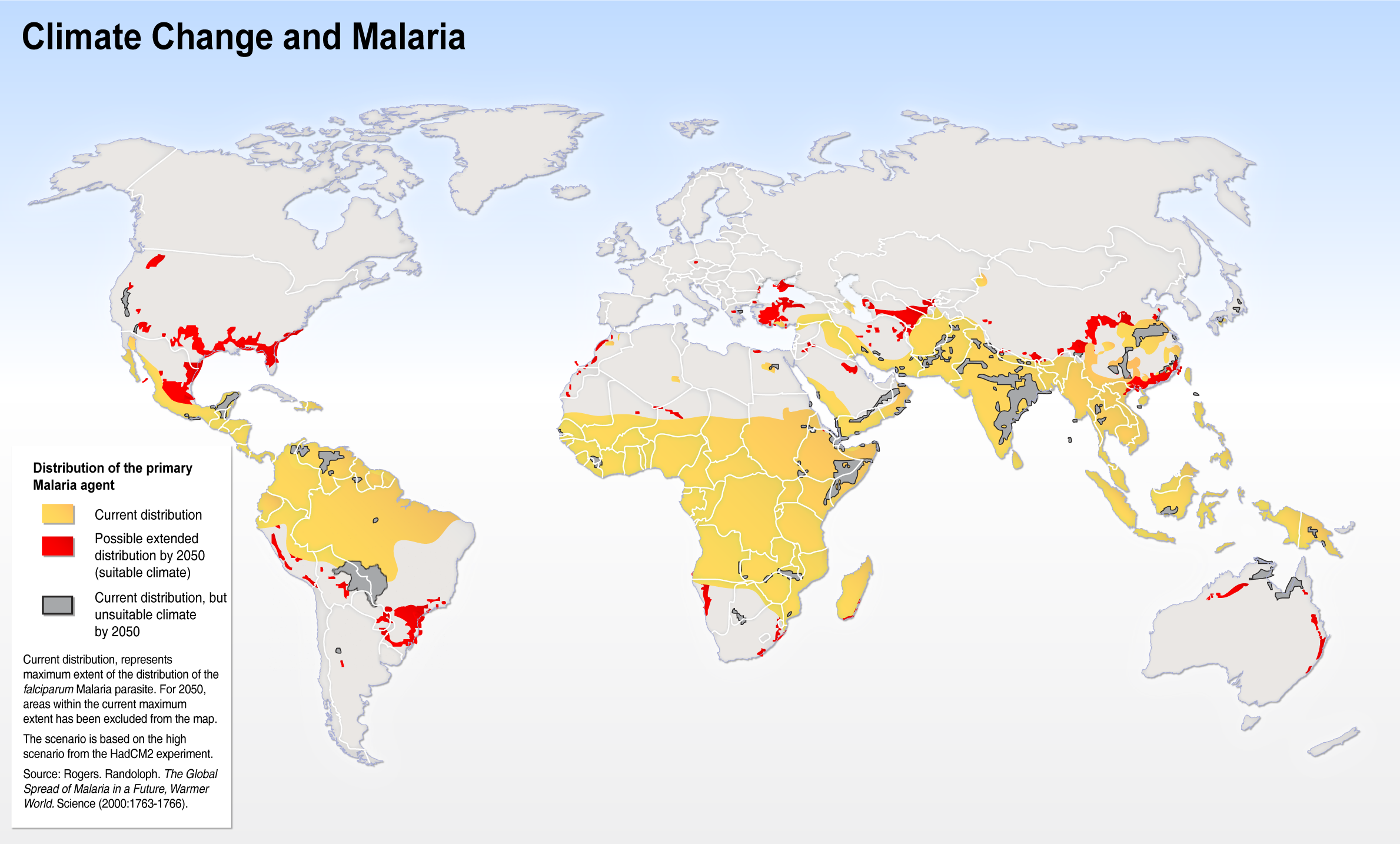Chapter 6. Chapter 6: Environmental Health
What can be done to reduce environmentally mediated health problems?

Guiding Question 6.5
What can be done to reduce environmentally mediated health problems?
Why You Should Care
Reducing environmental disease always involves identifying and then minimizing the environmental factors that cause the disease. For any mosquito-based disease (like malaria and West Nile virus), this means minimizing mosquito breeding by draining standing water in tires or puddles, and also minimizing feeding by using nets and pesticides to decrease chances of mosquitoes biting humans.
For other hazards, the main goal is always educating people to minimize their contact with the disease vector (like the ponds infected with Guinea worm disease) and recognize their actions that spread the disease (like not isolating themselves when the Guinea worms infect their body).
Certainly, no program of education and action is going to totally eliminate an environmental disease, but it can reduce infection and break the cycle of parasite and host, and drastically decrease the chances of infection in the future.
Question 6.1
X6VLd8hNIh3dJ4EW8qyQL7cyxwNbwfHcqm+AoSI0PQBV9HmC7FeKiIVMpQbPU0NCRDR03wQXPD2lxYcayID5Kq+SKdYvSYmvAh2E3DklD7TtxjPh+AnO0ZFwZPMiDkBj1VyuXb/gYExfxSSX5dTzUW5Sg6BxM68RvRaQJ3MOdcD0uhr9v1EFfIkWVrKqJVLIYFcdlHRBVnGTdT06J3lC4nrBhBm8BkVyYfEaaUEKxKinQDTNCcB9HTKP6r2zN4CTrJ4HxCOK2YyvrwmvoQaFXwW8X1HTMgXfa1d7KpO1VqYMzRL03Zdq00RVKSxsKQM1NVv3W5HBl/Gc7nIXdjXXCHzDgosMdIEt76eAPFmqC6Xu3QouAIdYB78v5Kldk12neei590vTyh92UDoa8HnF61gJbnk5yJSFyOHtnrO59+a9rJiUbxzTyCaRS/3o/1jPQhih3wTosy1kayqDCmxm9M4jDO5cfOhhDOvFGg==Question 6.2
QssJ4dcdB7b751WmJJFwV3LuVAoTdaaIJ19E/IMtotJKiODyd7CYvWLMkTm9H2/uQ3wFwVV6RQOekusjomcdxfEwwYwd8cavop5cTnoAPNS+4i9deIcWCPYY8yyweHx/OfJHkmwiOQe4Q+0Vxq87faqynkR7DOJcvXQj9BcRwiB3+jgNJdmZDymzKchCZEGGSFcK4/Ai5u0NwUXqeAd3/GJFmr/1KrKpwQFHlXKOJdVFBmYTmaynJK/aeHng/wFEKFr8ZSVS8mdAQn8Axv0yB4QUmN9jKdRpsMKnfxudxJ1Sr6zTol16qK+vE4pPbi7pdDV0ni6lJ6efs3hBzUu1xmlEd+El6Mr+CSNKo5Q4pw2i5YAyGrRbTPf96k+sMZ/uShX07w==Question 6.3
lzh9977yA5tFr1OLYm0BnYCRkLPvCeR6USx+uu4zMiPapv8/YipB5png583IFCZOn6E8JzEx/ZfyTFJ1gO7JkO3k5lFUHPzgloadIIdrFxZjLfsZ4ePqFEgjyY8unZytOAXJzOB2kD8z9jgYcck7PAdOMdHpvUsXWRxZJo/21gIszsFWhc8xPMF4TEI7r6eNiLrdVK9LidocDLo5/l5iYn4FymWwNkjYSqgszyLeeUoVPqofRzVNMxoD9rf9lbWdlgB1sXahfWaW4bguXFUeuKrWg4cMBlfVOIx47ZorcrBzQEyu2g8JRb3ReaiJommZYJ1Zuaa3WtyFqJZsu8UiOqTotko9BYS3fVQciu2Zom6LHDLpGW8AMB9DenmFqBfEpGGYwEWI8W5ibAvr8DlcNIoVfxLadeKEUaK9HPxapl/ACSlzVDXiaVqvrRzveidRZ4+zxTh+uSM=Question 6.4
+dEbk6uxWB6uST5Hm8ovmOLjOKnbPrZ8WWF0gLg/mU7TaMjr1Q41FwywmGwCl2jgKRPZxsVAePh70WssVqH3yqptLxrTEC9VnLY5oXAi5YFRab2U183hn0kVR8qttV2NjHrnsBYMBXmHcVsox1BbdrgIpsx7xEOvnYNvCkqvzbWspc/U02KkhkYGqglYucSYst3JEHDBpYNY8Ovlj7Aa+NnQZgUFF1shItIQOqE0ZiHTziBc7SBmAP0DwWY0M23+aacJmy4uOqW7fyNCa0ImSmM81SkAshfNyMvqzlk2t5ZRN9VHf4seggmGo9cj9R1qcrDNtdkb7fWBv0ysquSy8hKXzbj46rnqhVw7oHzqfZZHLqG98ENCeQ==Question 6.5
oPDtqA7aHXTm17uFYtMkpxIo8ZmF5FipN9SHITjIP62HYV7oOC0KNGZCTXJe5/46UjN+lia1/sG6wUVOu6Nto56q+VA2mv15YYvCO9Mfddo=Question
Short-Answer Questions
Climate change is predicted to increase temperatures over wide swaths of the planet and so allow tropical diseases to exist farther north and south of the equator. This warming will expand regions of concern for many diseases that are just beginning to be contained, such as malaria, dengue fever, and parasitic worm diseases like schistosomiasis and trypanosomaisis.
The map below shows the predicted spread of malaria by 2050 using one of the higher temperature scenarios of climate change. The areas that are in yellow show current extent, and the ones in red are the expanded extent of malaria as climate permits its host to exist. Notable areas of expanded range are the Deep South of the United States, central Mexico, southern Brazil, Turkey, and Southeast Asia. These areas contain several hundred million people today.

Malaria is widespread in Africa today and flourishes where temperature is warm and rainfall leads to standing water. Efforts to prevent malaria include seeking medical solutions as well as changes in land-use as clearing forests for farmland increases breeding ponds for the mosquito that spreads the malarial parasite.
This expanded range compounds the environmental health emergency, especially among refugees fleeing tropical areas, and potentially increases the spread of these diseases among new, densely packed populations that have never been exposed to malaria.
For the following, assume you are a health official for one of the areas in red on this map.
soti2JCkjIEsv8aUwi/QDA1XQPg4sFfGim+7OaWUqQp3ARFlE781N6CuddadTf2XPyhJeeUj2r5mPhzRCzpo5SxNxV4ud0B5ITZwFokX8Au3MBGg2BFi+7iOIUkTTmsEnKO9KDGrLH5KmX62rtmRVKLDcvdCAVDSb6fdYjn2iPzGJhJwYyUiu3DLIn+tFa8VJKFWHoVH47zgcp6AuUbQ5A8fQ5kc/xuSodj1hER5C3uSuW4FUIm/XHVn0Tl+6Mp6ypT0dpboufNYmyjI26w6aVn6Sgs= Uzh+vKzf7ZJEAoveb5gpi8/F3rq3hig4eayoGhT8sNKGixnikjbPnQQTnFaVy2HZ0rItJ3K7ZXU14QtEN4azdyAEq2D6arQelwK5Pq/P2dProMNOnGIDlF7e3OiU96s6qvK8gAo8DMMscIaw3aaqevh+85zH7ieH X++hv/GR6dVq7ZVB1fZrrVFLoUAmufv4wFv37vjZ5yKuGvu5kYRbwW93OY9Gf8/jrxxf1Va0o/nWKV/PuSbqs8CsDCNPDLeWWqrH7S+BDNvcUrDzk2cZraV6bZGdWI85R5w5qQ8sCvPJQOVVTh9SwDRnFL3lP32OGHpcdOC3dSKVWOFiNwGbrqGEjHxvIqj/fcwrawaWeAujDXMbWbeYwZnhEgJVsVxxbKVpY3JjZ2EFH2M+a5UholldUUudv46f2nDDprTiDsrblZK+TnUwxH861gDXZB87IGbBZwSt4SDY+PGBlvYNeuW729eqmOKq+40jTR5aYiLoUd3h6mxiO/M/0OOhXUEYFsRkzNWqnO5ZtP96ZWDq+SXdR+9/XfImpkBDEbt20TYJ0VECXpNmhA==2) Since malarial regions will increase into more populated areas by 2050, research today should benefit far more victims than are affected today.
3) If climate change increases faster or unexpected outcomes like this spread occur, health departments should view regional problems as potentially national problems from the beginning. All programs should be implemented as widely as possible—not just in affected zones today, but in all neighboring zones simultaneously.